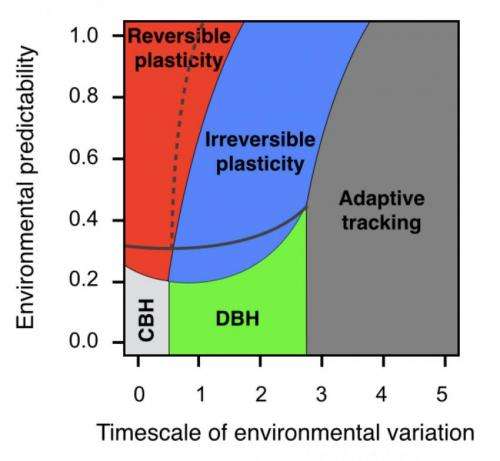Environmental 'tipping points' key to predicting extinctions

Researchers from North Carolina State University have created a model that mimics how differently adapted populations may respond to rapid climate change. Their findings demonstrate that depending on a population's adaptive strategy, even tiny changes in climate variability can create a "tipping point" that sends the population into extinction.
Carlos Botero, postdoctoral fellow with the Initiative on Biological Complexity and the Southeast Climate Science Center at NC State and assistant professor of biology at Washington State University, wanted to find out how diverse populations of organisms might cope with quickly changing, less predictable climate variations.
The research appears in the Proceedings of the National Academy of Sciences.
"Organisms tend to adopt a strategy for dealing with changes in their environment," Botero says. "Some of them adjust their gene expression either at birth or throughout their lifetime, which we refer to as irreversible and reversible plasticity. Some do what we call 'bet-hedging,' producing offspring that are adapted to one of two possible outcomes so that at least half of their offspring survive, and some rely on plain old evolution - which we call adaptive tracking - to keep up with environmental changes. We wanted to determine which strategies worked best under certain circumstances, and find the point at which that strategy would no longer be viable."
Botero and colleagues Franz Weissing from the University of Groningen, Netherlands, Jonathan Wright from the Norwegian University of Science and Technology and Dustin Rubenstein from Columbia University, created virtual organisms that were able to modify their insulation - or how they might respond to temperature changes through coat thickness, sweating, etc. - to adapt to the environment, and then placed them in simulations with areas of fast and slow temperature variation and high and low predictability.
The results mapped to a series of "zones" where each adaptive strategy worked best. For example, organisms that used reversible plasticity as a strategy did better in a highly predictable environment, even if the rate of environmental change was rapid. Organisms that relied on adaptive tracking, however, did fine regardless of predictability, as long as the rate of change was slow.
But when the organism got close to the edge of its zone, the smallest variation in either predictability or rate of change led to rapid extinction. The researchers found that these tipping points could occur even with changes that seemed statistically insignificant.
"These results were in line with what we would expect," Botero says. "Within their zones, most of these strategies allow for some variability - and in some cases, the changes within zones can be really huge without much effect on the organism. But when the organism gets close to the margin of another zone, even the tiniest change in either predictability or rate of environmental change can result in immediate extinction, because the initial adaptive strategy no longer works.
"We hope that this model can serve as a first step in the process of locating populations that exist close to these boundary areas, so we can better identify species that are most at risk of extinction."
More information: Evolutionary tipping points in the capacity to adapt to environmental change, PNAS, www.pnas.org/cgi/doi/10.1073/pnas.1408589111
Journal information: Proceedings of the National Academy of Sciences
Provided by North Carolina State University

















